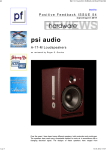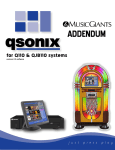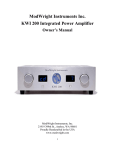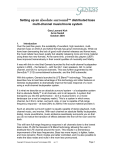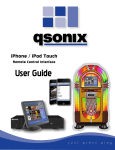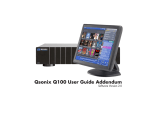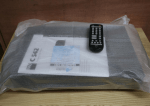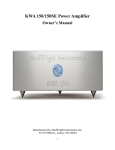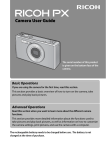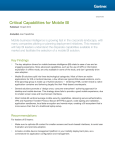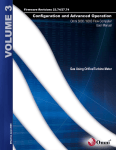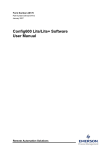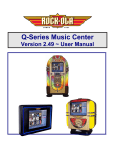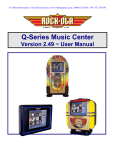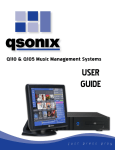Download The Audiophile Voice reviews Qsonix Q105
Transcript
Qsonic Q105 Music Management System S Bascom H. King INCE I HAD HEARD quite a few interesting things about the Qsonix and other music systems and being professionally involved in some of the various ways to play digital music that have evolved recently, I had some considerable interest when I was offered a chance to review a Qsonix Q105 system. The Q105 is the newest and most affordable music server from Qsonix and is basically a simplified version of the Qsonix Q110 machine that has been both widely and favorably reviewed. To make the Q105 more affordable and attractive to a wider range of music lovers, some of the features of the Q110 have been left out. Chief among these is the advanced RS232/TCPIP communication protocol for multi-room or whole house automation, a feature where integration with third-party control or automation systems is desired or required. Other simplification steps eliminated the capability of hard-wired IR integration and the reduction of the num- 00 ber of discrete audio outputs from four to two. However, the Q105 has the same extensive software feature set as the Q110. The SP/DIF digital output used with an external DAC makes the Q105 an especially desirable setup for playing one’s music with high quality sonic results. Of course, the system’s two sets of analog outputs work well, too, and allow separate music outputs with separate playlists to go to two systems in one’s home. When it came time to get the equipment, Mike Weaver, President of Qsonix, drove up from the home of Qsonix in Westlake, CA, up to Santa Barbara, CA, where I live. After meeting each other and bringing in two boxes of the Qsonix equipment, one for the touch screen monitor and the other for the server itself, we discussed the various ways to connect it all up. I had the idea that I wanted the touch screen controller to sit on a small table right to the right of my listening chair. the audiophile voice Where to put the server was more open to options; I decided to place it on the side of my listening room where my system preamp and other gear reside. This made it just about perfect for the length of cable Weaver brought along to connect the server to the touch screen; a distance was about 12 feet and the cable was 15 feet long. of the Q105 can be found on the Qsonix web site, www.qsonix.com. Click on the download item at the bottom of their home page for a list of very informative items including the user manual for the Q105/Q110 machines. The touch screen is divided into six main areas. At the left and covering approximately two-thirds of the I really enjoyed using the Qsonix Q105. It offers a simple, reliable and yet ultra-sophisticated way to store, manage and listen to high-quality sound files. The machine Mike brought for review had been most recently at the 2009 Rocky Mountain Audio Fest and had a lot of music material loaded on its 500-GB hard drive. I decided on a long 25-foot Ethernet cable that I had to connect the server on the music system side of my listening room over to the other office side and into my Ethernet router. With the Q105 up and running, Mike quickly walked me through some of the fundamentals of operating the system and spent some time telling me about the way the server gets the CD album information from the Internet. He mentioned that their operating system software is quite a bit more sophisticated than most of the other music systems. After returning from lunch, I got a few more pointers, and after Mike left, I was on my own. A user interface such as that of the Q105 is quite sophisticated and extensive. I will explain a few of the more salient features as I Fig. 1 -- The initial entry or describe my experience in learning and using it. More operating window of the Q105 is the Touch Screen. complete information of the features and operation screen, a menu bar is at the top, an album browser control at the bottom, with the majority of the remaining area devoted to the album browser display. The righthand third of the screen is divided vertically from top to bottom into a display of playlists, the currently loaded playlist, and at the bottom, the playback controls. The general idea in using the Q105 is to select albums or tracks of albums in the album browser display area and drag and drop them over into the playlist area. Being a touch screen, this dragging and dropping is done with one’s fingertips on the screen. (See Fig. 1.) Probably the most operationally important item in the top menu bar is the View Mode Menu button at the top left. This gives a menu of the various ways to view the music files on the Q105. Fig. 2 -- Here the Touch Screen’s These include: View Mode Menu has been set Album, Artist, to display album covers. Genre, Cover, Volume 13, Issue 6 00 my favorite music but also to compare the sound of these albums or tracks via the Q105 to the sound of the same tracks played from my reference optical disc playing machines. I was also interested in the idea of controlling the Q105 from my computer while I worked. Mike Weaver had showed me two neat web applications that I put on my Vista laptop computer to do this. One was a Microsoft Internet Explorer application that showed the View mode choices as tabs along the top with album and playlist information below. The other was an Apple iPhone/iTouch image that looked like what one would see with an actual iPhone/iTouch device controlling the Q105. These web apps would allow me to control the Q105 away from the touch screen while working over in my office side of the listening room. Since I had wanted an Apple iTouch for some time, I got one to try on the Q105, among many other things. It worked well and I could control the Q105 via my wireless network from wherever I happened to be in my house. Way Cool! I spent most of my listening time using the SP/DIF digital output going into either a PS Audio DLIII or the new PS Audio PWD. I did listen to the analog outputs and found them to be very good but not quite as good as using the external DACs. In addition, there were some popping sounds when changing volume on my Wyred4Sound STP-SE preamp when the Q105 was first turned on, suggesting some d.c. offset in the analog outputs but this slowly went away after some five minutes or so of operation. At one point later into using the Q105 and writing up the review, and just after putting some more of my CDs into the system, in particular, BHK Faves #1 - one of my favorite compilations, I played some of these tracks back through the Q105 directly into the PWD. Then I played the original CD on my UDP-1 into my Genesis Technologies Digital Lens and into the PWD. Here the sound was better and more defined as is usual going through the Digital Lens. Putting the feed out of the Q105 into the Digital Lens brought things toward being more nearly identical. In my long-term experience, the Digital Lens always does this for a digital signal feed. Going to my ModWright-modified Sony NS9100ES player, I was again reminded why this is my reference CD player. Sound was noticeably more detailed, relaxed, and present playing the same CDs. Still, in the final analysis at the end of the review period, I was listening to several albums on the Q105 directly into the PWT and using my SF tube power amp and the DTG module preamp, and I must say, that the sound from this set-up was very, very good and enjoyable. I can see how a system like the Q105 could be quite compelling for a certain group of people who would like all their music available with a great interface like the Q105 has. Personally, for me, being more of an engineer, designer, experimenter, and reviewer of highend audio equipment, it wouldn’t suit me as a sole source of my music, as I play music from numerous sources like computer, iTouch, and the disc players. I would say that loading a large collection of CDs into a system like the Q105 would be quite time consuming, Fig. 3 -- What the window for the “system tab” looks like when opened. Located here are controls for most key system settings. Year, Search, Tapestry, All, Recent, and Imported. An image of the touch screen with the View Mode Menu set for Cover is shown in Fig. 2. The other View Modes come up with a list of the appropriate sort variable. Clicking within these lists then displays the album covers two at a time within the browser area. At the right end of this menu bar is an icon for tools. This gets into a whole range of system variables with two tiers of tabbed pages. The upper tabbed section has the headings: System, Network, CD, Playback, iPod, and Information. Each of these main tab headings has sub tab headings with appropriate things to control. An example of the system tab is shown in Fig. 3 First off, I started exploring some of the music on the machine. Not yet being familiar with the many facets of the interface, my method was to randomly sample cuts from albums of interest by putting them in a playlist and then playing them. If I was fond of a particular playlist, it could be easily named and saved. I found that I liked quite a lot of music on the Q105 and saved a number of playlists. At one point early in the process of learning and using the Q105, I had ripped some CDs into the machine and put them all in a genre that I defined as “BHK 0” so that I could easily and rapidly identify those I had put in the machine. My idea was enjoy some of N O T E S Qsonix Q105 Music Management System, $4,450.00. Qsonix, 31119 Via Colinas, Suite 501, Westlake Village, CA 91362-3933, phone 877/477-6647, fax 818/584-8998, Live Chat at web site www.qsonix.com. Associated Equipment Genesis Advanced Technologies (GAT) 6.1 speakers and G928 subwoofers, Sonic Frontiers Power One and Wyred4Sound ST 250 power amplifiers, Wyred4Sound STP-SE & DTG module experimental preamplifiers, Genesis Technologies Digital Lens, PS Audio DLIII and PWD external D/A converters, and ModWright/Sony NS9100ES and McCormack UDP-1 SE compact disc players. 00 the audiophile voice although I understand that there are for-hire services that will do this for moderate fees. In addition to directly ripping CDs, the Qsonix systems presently accept importation of MP3, FLAC, and WMA music files. Having a number of FLAC files from various sources and resolutions, I attempted to load some of them into the Q105, both from a thumb drive into the USB input and as a network source on my network. Try as I might, I wasn’t able to make this work. I got lots of support about this from Qsonix along with strong assurances that thousands of customers do this routinely. I think not making this work as due to my own inability to sufficiently understand Windows networking and my own failure to do that last small thing needed to succeed. I have a few nits to pick on my experience with the Q105. The particular touch screen was variously difficult to use in that it took a lot of pressure to drag and drop an album into the playlist space: I needed to use more than one fingertip. Yet, the drop-down menus, and their subsets of items to click on, worked much more easily. Calibrating the touch screen, which is an easy procedure, didn’t help this. I am sure that units shipped to customers are better in this regard. I found the open/close button on the CD transport to be kind of hard to work, especially when the drawer was out and I couldn’t see the button. Aside from these fairly small items, the system worked flawlessly. In conclusion, I really enjoyed my time with the Qsonix Q105 and it was a good addition to my other sources of music. It is a well thought-out and implemented system and, due to its more affordable price, the Q105 will likely find its way into many more music lover’s systems. 1/2 Horizontal Ad Volume 13, Issue 6 00




